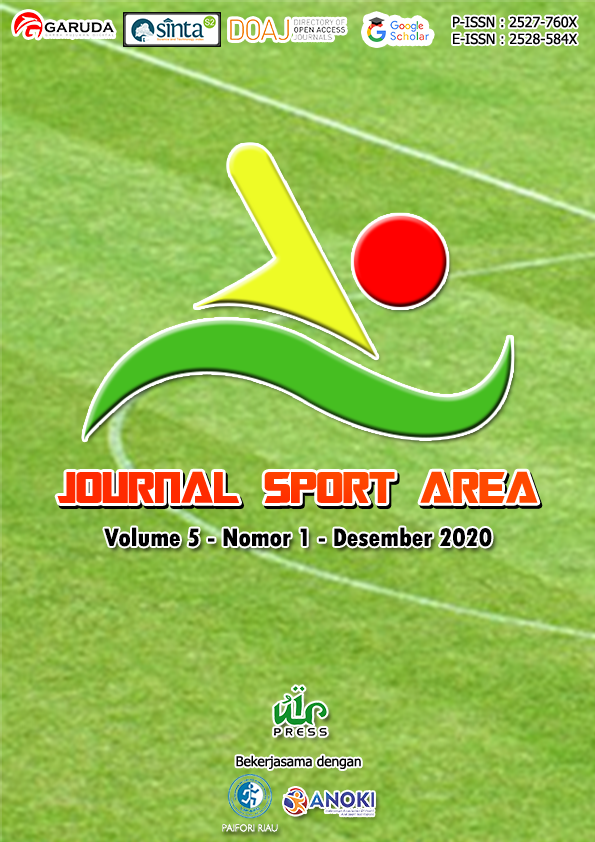Complex Training: Efektifitas Latihan Dalam Meningkatkan Power Otot Pada Atlet Bola Voli Remaja
Keywords:
Complex Training, Power, Legs Muscle, Arm MuscleAbstract
Complex training is an exercise method that combines plyometrics with strength training. This exercise is an exercise used to increase muscle power. This study aims to determine the effect of training of complex training methods towards leg muscle power and arm muscle power for adolescent volleyball athletes. The method used in this study is an experiment with a control group pretest - post test design. Subjects in this study are 23 adolescent volleyball athletes (14-17 years old) with 12 males and 11 females, who are divided into two groups of experimental groups (n = 12) and control groups (n = 11) with randomized matched pair design based on the ranking of the vertical jump ability. Instrument used in this study is vertical jump test (leg power) and the medicine ball throw test (arm power). The data analysis technique uses the paired t-test with a significance level of α = 0.05. The results show that training using a complex training method provides a good benefit in improving leg and arm muscle power. Therefore, this method is appropriate for used by adolescent volleyball athletes that have had experience of weight training in improving muscle power towards adolescent volleyball athletes
Downloads
References
Ali, K., M, E. H., Verma, S., Ahmad, I., Singla, D., & Jha, P. (2017). Complex training: An Update. Journal of Athletic Enhancement, 6(3), 1-5. https://doi.org/10.4172/2324-9080.1000261.
Blazevich, A. J., & Babault, N. (2019). Post-activation Potentiation Versus Post-activation Performance Enhancement in Humans: Historical Perspective, Underlying Mechanisms, and Current Issues. Frontiers in Physiology, 10(November). https://doi.org/10.3389/fphys.2019.01359.
Carter, J., & Greenwood, M. (2014). Complex training reexamined: Review and recommendations to improve strength and power. Strength and Conditioning Journal, 36(2), 11–19. https://doi.org/10.1519/SSC.0000000000000036.
Dawes, J., & Roozen, M. (2012). Developing Agility and Quickness (NSCA Sport Performance), 2nd Edition. Champaign: Human Kinetics.
De Salles, B. F., Simão, R., Miranda, F., Da Silva Novaes, J., Lemos, A., & Willardson, J. M. (2009). Rest interval between sets in strength training. Sports Medicine, 39(9), 766–777. https://doi.org/10.2165/11315230-000000000-00000.
Faigenbaum, A. D., & Myer, G. D. (2010). Resistance training among young athletes: Safety, efficacy and injury prevention effects. British Journal of Sports Medicine, 44(1), 56–63. https://doi.org/10.1136/bjsm.2009.068098.
Fukuda, D. H. (2019). Assessments for Sport and Athletic Performance. Champaign: Human Kinetics.
Lim, J. J. H., & Barley, C. I. (2016). Complex Training for Power Development: Practical Applications for Program Design. Strength and Conditioning Journal, 38(6), 33-43. 10.1519/SSC.0000000000000265.
Lloyd, R. S., & Oliver, J. L. (2012). The youth physical development model: A new approach to long-term athletic development. Strength and Conditioning Journal, 34(3), 61-72. https://doi.org/10.1519/SSC.0b013e31825760ea
Lorenz, D. (2011). Clinical Commentary. The International Journal of Sports Physical Therapy, 6(3), 72-87.
Lorenz, D. (2011). Postactivation potentiation: An introduction. International Journal of Sports Physical Therapy, 6(3), 234-240.
Macaluso, T. D. (2010). Periodization and complex training in a high school summer program. Strength and Conditioning Journal, 32(6), 95–98. https://doi.org/10.1519/SSC.0b013e3181e8e30b
Mansur, L. K., Irianto, J. P., & Mansur, M. (2018). Pengaruh latihan squat menggunakan free weight dan gym machine terhadap kekuatan, power, dan hypertrophy otot. Jurnal Keolahragaan, 6(2), 150-161. https://doi.org/10.21831/jk.v6i2.16516
May, C. A., Cipriani, D., & Lorenz, K. A. (2010). Power development through complex training for the division I collegiate athlete. Strength and Conditioning Journal, 32(4), 30-43. https://doi.org/10.1519/SSC.0b013e3181dd8f47
Mohamed, G. A. (2011). Effects of Complex Trajning on Certain Physical Variables and Performance Level of Landing in Floor Exercise. Ovidius University Annals, Series Physical Education & Sport/Science, Movement & Health, 11(2), 171-175.
Reynaud, C. (2011). Coaching Volleyball Technical and Tactical Skills. Champaign: Human Kinetics.
Shariat, A., Kargarfard, M., Danaee, M., & Tamrin, S. B. M. (2015). Intensive resistance exercise and circadian salivary testosterone concentrations among young male recreational lifters. Journal of Strength and Conditioning Research, 29(1), 151-158. https://doi.org/10.1519/JSC.0000000000000632
Smith, C. E., Lyons, B., & Hannon, J. C. (2014). A pilot study involving the effect of two different complex training protocols on lower body power. Human Movement, 15(3), 141-146. https://doi.org/10.1515/humo-2015-0003
Talpey, S. W., Young, W. B., & Saunders, N. (2016). Is nine weeks of complex training effective for improving lower body strength, explosive muscle function, sprint and jumping performance?. International Journal of Sports Science and Coaching, 11(5), 736-745. https://doi.org/10.1177/1747954116667112
Thompson, T., Berning, J., Harris, C., Kent, J., & Debeliso, M. (2017). The Effects of Complex Training in Male High School Athletes on the Back Squat and Vertical Jump. International Journal of Sport Science, 7(2), 50-55. https://doi.org/10.5923/j.sports.20170702.05
Published
How to Cite
Issue
Section
This is an open-access article distributed under the terms of the Creative Commons Attribution-ShareAlike 4.0 International License which permits unrestricted use, distribution, and reproduction in any medium. Copyrights of all materials published in Journal Sport Area are freely available without charge to users or / institution. Users are allowed to read, download, copy, distribute, search, or link to full-text articles in this journal without asking by giving appropriate credit, provide a link to the license, and indicate if changes were made. All of the remix, transform, or build upon the material must distribute the contributions under the same license as the original.
Accepted 2020-10-02
Published 2020-11-24












